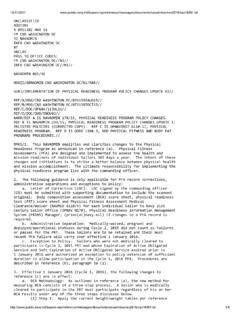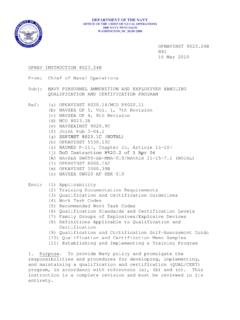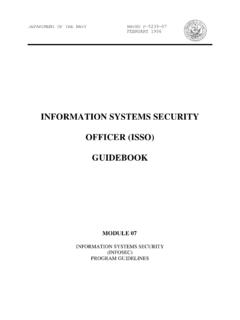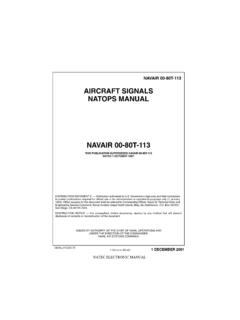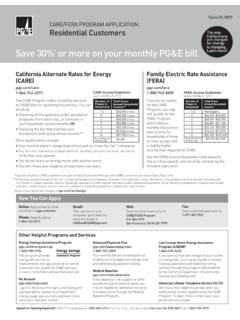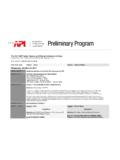Transcription of FOOD SERVICE MANAGEMENT GENERAL MESSES
1 food SERVICE MANAGEMENT GENERAL MESSES NAVSUP Publication 486 Volume II, Revision 8, AUG 2016 COG 01 STOCK NO. 0530-LP-011-1940 NAVSUP P-486, Rev 8 food SERVICE MANAGEMENT , Volume Two i Although the words he, him, and his are used sparingly in this manual to enhance communication, they are not intended to be gender driven nor to affront or discriminate against anyone reading this manual. NAVSUP P-486, Rev 8 food SERVICE MANAGEMENT , Volume Two iii CONTENTS NAVSUP P486, VOL II CHAPTER 1 NUTRITITION / MENU PLANNING / SPECIAL MEALS CHAPTER 2 MESS DECK MASTER at ARMS/FSA OPERATIONS CHAPTER 3 PRESENTATION SILVER CHAPTER 4 AFLOAT WARDROOM AND STATEROOM SERVICE CHAPTER 5 OFFICERS MESSES AFLOAT CHAPTER 6 CHEMICAL BIOLOGICAL RADIALOGICAL DEFENSE CHAPTER 7 SAFETY - 3M CHAPTER 8 food SERVICE EQUIPMENT OPERATING AND CLEANING PROCEDURES CHAPTER 9 ASHORE food SERVICE , FACILITY STRUCTURE AND HOUSEKEEPING CHAPTER 10 WASTE MANAGEMENT OPERATIONS CHAPTER 11 HEIMLICH MANEUVER CHAPTER 12 food MICROBIOLOGY INDEX NAVSUP P-486, Rev 8 food SERVICE MANAGEMENT , Volume Two iv THIS PAGE INTENTIONALLY LEFT BLANK NAVSUP P-486.
2 Rev 8 food SERVICE MANAGEMENT , Volume Two 1-1 CHAPTER 1 NUTRITION AND MENU PLANNING Part A: NUTRITION STANDARDS Purpose .. 1000 Weight Control .. 1001 Part B: NUTRIENTS AND MICRONUTRIENTS Nutrients .. 1100 110 1 Part C: NAVY MENU Menu Review Process (Ashore/Afloat).. 1200 Cycle Menu .. 12 01 Menu Planning Procedures .. 12 02 Menu Approval .. 12 03 Menu Changes .. 12 04 GENERAL Nutrition 12 05 Menu Planning and G4G Nutrition Standards for Entrees .. 12 06 Menu Planning and G4G Nutrition Standards for Starches .. 12 07 Menu Planning and G4G Nutrition Standards for Vegetables .. 12 08 Menu Planning and G4G Nutrition Standards for Desserts .. 12 09 Menu Planning and G4G Nutrition Standards for Salad Bars and Fruit 1210 Menu Planning and G4G Nutrition for Beverages.
3 12 11 Healthy Ingredients .. 12 12 Marketing Menu Items .. 12 13 food Combinations, Scheduling, Variety and Innovation .. 12 14 Characteristics of an Aesthetically Pleasing 12 15 Speed Lines .. 12 16 Brunch .. 1217 Night Meals .. 12 18 Special Meals .. 12 19 Part D: food HANDLING AND NUTRIENT RETENTION food Handling .. 1300 food Preparation .. 1301 As Purchased (AP) and Edible Portion (EP) .. 1302 Temperature Monitoring .. 1303 Preservation Packaging and Packing for food Items ..1304 Part E: ADVANCED food Advance Foods .. 14 00 Advanced Foods Descriptions .. 14 01 Part F: TRADITIONAL FOODS Traditional Foods .. 1500 NAVSUP P-486, Rev 8 food SERVICE MANAGEMENT , Volume Two 1-2 Part G: SPECIAL MEALS Special Meals .. 1600 Part H: food PRESENTATION GENERAL food 1700 Self SERVICE Serving Lines.
4 1701 NAVSUP P-486, Rev 8 food SERVICE MANAGEMENT , Volume Two 1-3 CHAPTER 1 NUTRITION AND MENU PLANNING PART A: NUTRITION STANDARDS 1000 PURPOSE 1. GENERAL . Navy nutrition standards are based on federal and military nutrition policy. These standards include the 2015-2020 Dietary Guidelines for Americans, the 2011 MyPlate, the National Academy of Sciences Dietary Reference Standards and the DoD Menu Standards. The 2015 2020 Dietary Guidelines for Americans are developed by the Departments of Agriculture (USDA) and Health and Human services (HHS). They offer the government s best advice on healthy eating. These guidelines help shape policies for school lunch and breakfast programs, Woman, Infants, and Children (WIC), and nourishment programs for the elderly and military.
5 They are based on evolving nutrition science. They also offer practical guidance on how to develop a nutrition plan. Tip #1: Think about your overall way of eating. You re eating pattern reflects how you usually eat. Each day doesn t stand alone so eating less whole grains one day balances your diet when you eat more whole grains on a different day. The Eating Pattern includes a variety of colorful fruits and vegetables, low-fat dairy, whole grains, and lean protein (focusing on Omega 3 fish). While similar, the Vegetarian-Style Eating Pattern consists of plant-based protein, more legumes, nuts, and seeds. Some vegetarians also eat eggs and fish. The Mediterranean-Style Eating Pattern includes slightly more fruit and seafood, and slightly less dairy.
6 Tip #2: Select a variety of vegetables. Choose vegetables from all 5 groups dark green, red/orange, dried beans and peas, starchy, and others (light green, purple, yellow, and tan). To ease shopping and storage, purchase all forms: fresh, frozen, canned, and dried. Add vegetables in new ways: grilled, roasted, and raw. Add spinach to a breakfast omelet, or have carrot sticks at lunch, and toss several different vegetables into your pasta dinner. Be creative, use fragrant spices, and prepare new recipes. Tip #3: Choose whole grains. Whole-grain foods include oats, brown rice, popcorn, and quinoa. They are typically higher in fiber and contain important minerals like iron, Select whole grains for at least half of your grain choices.
7 Look for whole-wheat flour as the first ingredient when buying breads, pasta, or other grain foods. Replace white flour with winter-white wheat flour; it s easy and barely noticeable. Tip #4: Limit the calories consumed from added sugars. A healthy eating plan is difficult to achieve when you consume too many sugar-sweetened beverages, snacks, and sweets. This goes for all forms of sugar (honey, molasses, and agave). The recommendation is to take in less than 10% of total calories from sugar. For a 2,000 calorie diet, that s 200 calories. Divide by 4 to get grams (50g) and by 4 again to get teaspoons (12 tsp). Read food labels to figure out where your sugar is coming from, and then cut back. One can of soda contains about 40g of sugar.
8 Tip #5: Lower saturated fat to less than 10% of daily calories. NAVSUP P-486, Rev 8 food SERVICE MANAGEMENT , Volume Two 1-4 What does this mean? A 2,000-calorie daily diet should include less than 20g of saturated fat. Check the nutrition facts label to see the total saturated fat content in your favorite foods. Most saturated fat comes from whole milk, cheese, butter, and fatty meats. Choose healthier fats such as olive, corn, soy, or safflower these contain poly- and mono-unsaturated fats. Swap whole fat dairy with 1% fat and reduce saturated fat. Tip #6: Reduce sodium. In an average American diet, most sodium comes from processed foods. Common foods include pizza, canned soups, cured meats, and store-bought breads. Whole grains are encouraged; however, bread is a source of sodium.
9 Some easy ways to lower sodium is to rinse canned vegetables before adding them to recipes. Also try new spices (curry powder, garlic, and ginger) when preparing foods and always taste before adding salt. 2. UNITED STATES DEPARTMENT OF AGRICULTURE: MyPlate. The MyPlate s sections encourage consumers to fill half of their plate with fruits and vegetables, one fourth with whole grains and one fourth with lean protein. a. MyPlate supports the 2010 Dietary Guidelines for Americans with easy-to-understand messages. The brightly colored and simply worded symbol is appealing to consumers of all ages. MyPlate serves to remind individuals and families to adopt healthier lifestyles as America continues the fight against the obesity epidemic.
10 Some of the suggestions include: 1) Balancing calories: enjoy your food , but eat less 2) Foods to increase: make half of your plate fruits and vegetables, make half of your plate grains emphasizing whole grains, and switch to fat-free or low-fat (1%) milk 3) Foods to reduce: soup, white bread, frozen meals and sugary drinks 3. JOINT SUBSISTENCE POLICY BOARD DoD Menu Standards. The DoD menu standards are the minimum practical guidelines that military food SERVICE programs must use during menu planning, food procurement, food preparation, and meal SERVICE to support the nutrition standards as shown in Figure 1-1. The DoD Nutrition Committee will monitor, update, and provide implementation guidance to the JSPB on DoD Menu Standards as additional scientific information on nutrient needs become available.

